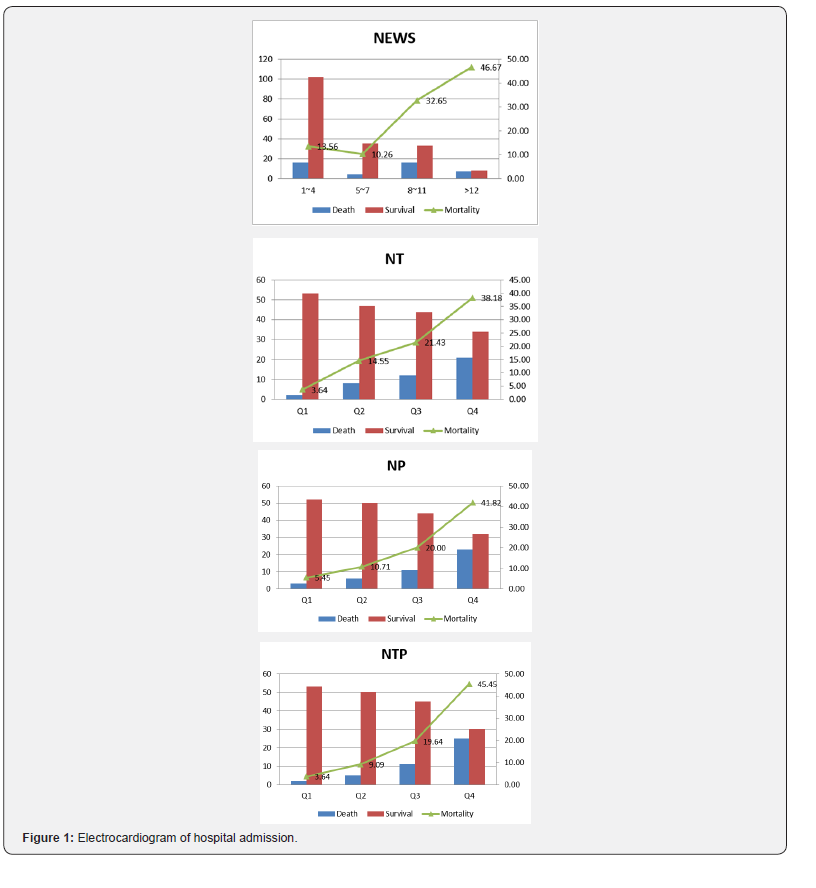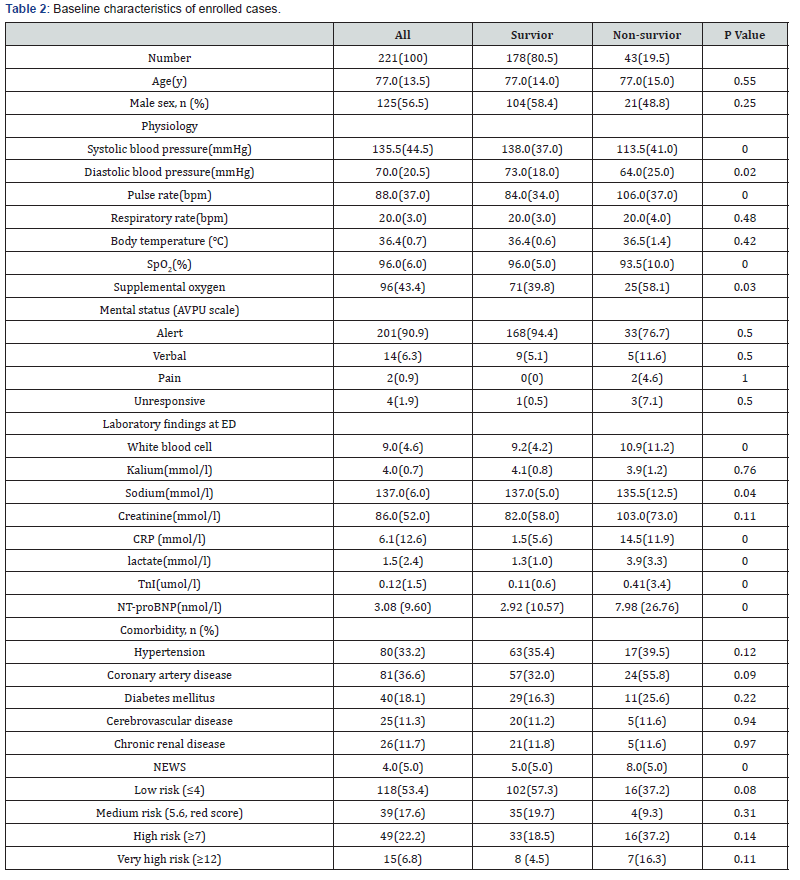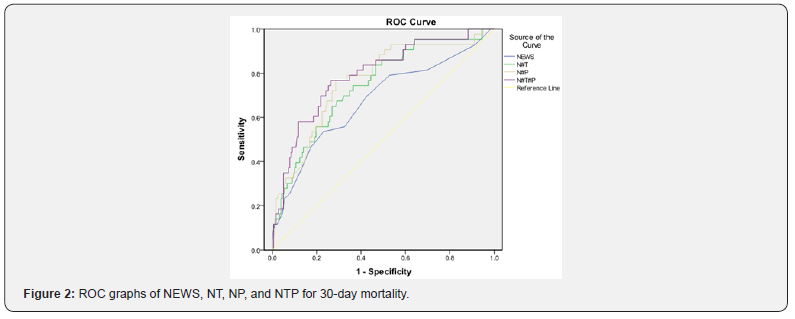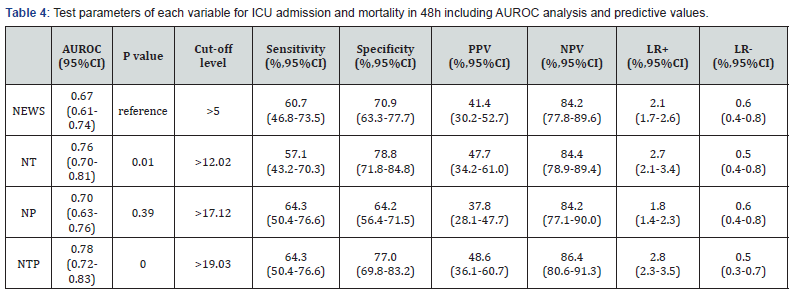Combined Use of the National Early Warning Scores (News), TnI and NT-proBNP increased predictive performance of NEWS in patients with Cardiovascular Disease
Xinchao Zhang1*, Lu Yang2, Kai Wang3, Shuangyu Yang1, Hu Zhen1 and Chunyi Fu1
1Department of Emergency, Beijing Hospital, Beijing 100730, China
2Department of Emergency, QingDao Municipal Hospital (Group), Qing Dao, 266000, China
3Department of Pharmacy, The Affiliated Hospital of QingDao University, QingDao 266000, China
Submission: January 06, 2020; Published: January 31, 2020
*Corresponding author: Xinchao Zhang, Department of Emergency, Beijing Hospital, Dong Dan DaHua Road, Dong Cheng District, Beijing, China
How to cite this article:GXinchao Z, L Yang, Kai W, Shuangyu Y, H Zhen, et al. Combined Use of the National Early Warning Scores (News), TnI and NT-proBNP increased predictive performance of NEWS in patients with Cardiovascular Disease. J Cardiol & Cardiovasc Ther. 2020; 15(5): 555922. DOI: 10.19080/JOCCT.2020.15.555922
Abstract
Introduction: National Early Warning Score (NEWS) is able to evaluate the integral stress level and function status of the body through vital signs, TnI and NTproBNP can reflect the degree of myocardial injury and cardiac function to a certain extent. Whereas, there is no study working on the estimate value of the combined index of NEWS and TnI or NTproBNP in patients with cardiovascular disease so far. We assumed that the combined index was more strongly associated with prognosis compared to NEWS alone.
Method: This was a prospective observational cohort study of adult admissions to emergency department with the diagnosis of cardiovascular disease. NEWS was calculated respectively and combined with TnI and NTproBNP in multivariable logistic regression models. The primary outcome was 30-day mortality after ED arrival, capturing all patients with cardiac arrest at our institution.
Result: All of 221 cases were followed up in 30 days, the mortality in 30-day was 19.5% (43/221). 56 patients (25.3%) died or were admitted to ICU within 48h of ED admission. The area under receiver operator characteristic curve (AUROC) of combined index as NT, NP, NTP for 30d mortality were higher than NEWS alone (0.75, 0.77, 0.79 vs 0.67, p<0.05 respectively). The predictive value of NT, NTP were superior to the NEWS alone (AUROC: 0.76, 0.78 vs 0.67; p<0.05).
Conclusion: Combined indexes showed better able to predict values for 30-day mortality than the NEWS alone in cardiovascular disease. The combinations of NT, NTP also had better evaluating ability for ICU admission and mortality in 48 hours than NEWS
Keywords: National Early Warning Score (NEWS); Cardiovascular disease (CVDs); Cardiac troponin I (cTnI); N-terminal fragment of pro-B-type natriuretic peptide (NT-proBNP)
Introduction
Cardiovascular disease (CVDs) remains the number one cause of death globally: more people die annually from CVDs than from any other cause [1-2]. According to a World Health Organization report in 2016 [1], An estimated 17.5 million people died from CVDs in 2012, representing 31% of all global deaths. However, many patients with CVDs do not have significant symptoms such as chest pain and dyspnea, and this makes diagnosis challenging. Early diagnosis and prognosis evaluation of CVDs patients presenting to the emergency room is critical to save lives.
Early Warning Scores (EWS) are often used to identify patients at risk of deterioration [3]. There are many types of EWS used in clinic, to standardise EWS, the Royal College of Physicians introduced the ‘National Early Warning Score (NEWS)’ in 2012 (Table 1) [4], which has been widely adopted [5-6]. NEWS is associated with admission to a critical care unit and death in studies of patients with medical diagnosis [7-8]. However, there is poor evidence of the application of NEWS in CVDs.

Point of care testing (POCT), like cardiac troponin (cTn) and the N-terminal fragment of pro-B-type natriuretic peptide (NTproBNP) are popularly used to detect CVDs. cTnI has been well described as the preferred biomarker for diagnosis and prognosis evaluate of myocardial infarction [9-10]. NT-proBNP serve as serum biomarkers for the diagnosis of heart failure [11]. TnI and NTproBNP can reflect the degree of myocardial injury and cardiac function to a certain extent, and NEWS is able to incarnate the integral stress level and function status of the body through vital signs. Whereas, it is unknown whether cTn, NT-proBNP could improve the utility of NEWS in predicting clinical outcome.
The aim of this study was to investigate whether the combinations of NEWS, cTnI and NT-proBNP on admission to emergency department (ED) are associated with mortality in 30 days and intensive care unit (ICU) admission or death within the first 48h of hospital admission. We hypothesize that NEWS combined with cTnI and NT-proBNP is more strongly associated with outcome compared to NEWS alone.
Method
Ethics
Local research ethics committee approval was obtained for this study from the Ethics Committee.
Study design and setting
This was a prospective observational cohort study performed at the ED of the BeiJing Hospital. The nurse firstly triages patients on their admission to ED by their symptoms and vital signs such as blood pressure, heart rate. Secondly, doctor on call inquires symptoms in detail, checks the patients systemically and issues necessary examinations, in order to evaluate patient’s condition and decide whether the patient need to be treated in hospital or be admitted to an intensive care unit.
Data collection
The study included patients who were admitted to the rescue room on admission to ED with the diagnosis of cardiovascular disease such as acute coronary syndrome (ACS) and heart failure (HF) from 23 January to 30 September 2015. The diagnosis criteria of ACS and HF refer to guidelines [12-13]. The following were excluded: patients aged less than 18 years of age, any admissions with missing or invalid data, patients who stayed in the rescue room less than 24 hours, patients with advanced cancer, anyone who turned down or failure to observe the medical treatment.
Vital signs and baseline data such as sex, age was collected on admission. Vital signs measurements contained: heart rate, respiration rate, systolic blood pressure, temperature, SpO2, the inspired gas at the time of SpO2 measurement, and the patient’s conscious level (AVPU). Recruiting researchers use this information to calculate an early warning score. Besides, blood tests results including blood routine, blood biochemistry were extracted from the hospital databases.
cTnI, NT-proBNP levels for patients were measured on admission by recruiting researchers using PATHFAST immunity analyzer. The detection with immunofluorescence technique needs 250ul K3EDTA plasma to obtain results in 15 minutes. The diagnosis concentration for cTnI, NT-proBNP are 0.02ng/ml and 450pg/ml respectively. All the data were summarized together eventually.
Outcome measures
The primary outcome was 30-day mortality after ED arrival, capturing all patients with cardiac arrest at our institution. The secondary outcome was intensive care unit (ICU) admission or death within the first 48h of hospital admission.
Statistical analysis
We use SPSS version 19 to analyze the data (Lenovo, Windows 10). NEWS, cTnI and NT-proBNP are considered as continuous variables. Non-normally distributed data are expressed as the median and IQR. Categorical variables are reported as count and percentages. Comparison of non-normally distributed data was performed using the Mann-Whitney U test. For categorical data, the X2 test of Fisher exact test was used. Results were considered significant at a threshold of P<0.05(2 tailed).
To integrate the NEWS with TnI and NT-proBNP, we performed logistic regression analysis to calculate regression coefficients of predictors as previous research did [14]. The predictive values were tested using the areas under the receiver operating characteristic (ROC) curves analysis. The SEM and p values for the ROC were calculated following the method of Hanley and McNeil [15], as well as the comparisons between them was. Statistical significance was set at p<0.05 for all analyses. All results were reported along with their associated 95% CIs and p values.
Results
Data from 269 patients were eligible in the study. 23 patients with missing predictors were excluded from the primary analysis, 25 patients were excluded from the analysis because the followup result was not available, leaving 221 patients in the primary analysis (supplemental Figure 1).

All of 221 cases were followed up in 30 days. 56 patients (25.3%) died or were admitted to ICU within 48h of ED admission. The mortality in 30-day was 19.5% (43/221). 125 (56.5%) patients were men and the median age of all the cases was 77 (IQR 14). There were significant differences between survivors and non-survivors in 30 days in NEWS, TnI and NT-proBNP (0.41 vs 0.11umol/l, 7.98 vs 2.92nmol/l, p<0.05). Lactate, SpO2, diastolic blood pressure and CRP were also significantly lower in nonsurvivors (Table 2).

On a logistic regression analysis with 30-day mortality as the dependent variable and NEWS and TnI levels as the covariate variables, the coefficient of NEWS was 0.60 and that of TnI was 0.67. We rounded these coefficients up and composed formula as following: NT (NEWS-TnI) = NEWS + TnI (umol/l). In the same way, we designed another two formulas: NP (NEWS-NTproBNP) = NEWS + NTproBNP (nmol/l); NTP (NEWS-TnI-NTproBNP) = (NEWS*2) + (TnI*2) (umol/l) + NTproBNP (nmol/l). Figure 1 showed the number of patients and mortality rates of each class. NEWS was classified by risk level, the other three combined variables were divided into quartiles (NT: first quartile [Q1] < 3.07, 3.07 ≤ second quartile [Q2] < 5.76, 5.76 ≤ third quartile [Q3] < 9.43, and 9.43 ≤ fourth quartile [Q4]; NP: Q1< 9.78, 9.78 ≤Q2 < 19.07, 19.07 ≤Q3 < 33.40, and 33.40 ≤ Q4; NTP: Q1 < 9.18, 9.18 ≤ Q2 < 17.57, 17.57 ≤ Q3 < 33.14, and 33.14 ≤ Q4). The mortality of group with NEWS score below four was 13.6% (16/118), significantly lower than that of the group with NEWS score above 12 (46.7%, 7/15). In NTP parameter group, 30d mortality was 3.6% in Q1, 9.1% in Q2, 19.6% in Q3, and 45.4% in Q4. The same trend can be seen in NP parameter group. The distribution of patients and relevant ICU admission and mortality in 48h after ED arrival were shown in supplemental Figure 2, and the data tendency were similar to that on above.
We figured up the area under receiver operator characteristic curve (AUROC) to test the predictive ability of NEWS and TnI, NT proBNP for the primary outcome. The AUROC of NEWS, TnI and NTproBNP were all 0.67, 0.67, 0.74. The AUROC of the NT, NP and NTP scores were higher than that of NEWS alone (AUROC = 0.75, 0.77, 0.79, p<0.05). However, there was no significant difference between the AUROC of the NTP and NT or NP (p>0.05), although the AUROC of the NTP was larger than that of NT or NP (Table 3 & Figure 2).


The predictive values of the NEWS and joint parameters for ICU admission and mortality in 48h were compared also (Table 4, Supplemental Figure 2). The predictive value of NT and NTP were superior to the NEWS (0.76 vs 0.67, 0.78 vs 0.67; p<0.05). Nevertheless, the difference between the AUROC of the NTP and NT was not significant (p>0.05), although the AUROC of the NTP was larger than that of NT (Table 3 & Figure 2).
Diagnostic performance including sensitivity, specificity, PPV, NPV, LR+, and LR- were assessed (Table 2, 3). The cutoff value was calculated by the Youden index. Table 2 showed that at a cutoff point of 22.81 of the NTP, sensitivity, specificity, and NPV value were 76.7%, 73.6%, and 92.9%, respectively; better than those of the NEWS, NT and NP index. The efficiency index of the ROC for secondary outcome was showed in Table 3.

Discussion
The principal finding of this study was that the combined index of NEWS and TnI or NTproBNP exhibited a reformative ability to predict 30-day mortality in CVDs in ED compared with the NEWS alone. The NTP index showed the greatest ability to predict 30-day mortality, with higher sensitivity, specificity and NPV than NEWS, NT, and NP. We also found that NTP and NT showed better predictive values to ICU admission and mortality in 48h after ED arrival.
Recent studies have shown that NEWS had a poor to moderate value in evaluating the risk of patients and prognosis [7,16]. All of physiological variables included in NEWS can be acquired within a few minutes, making a rapid evaluation of patients possible. However, there is no effective system for rapid assessment of CVDs so far, only preliminary diagnosis by blood index such as TnI and NTproBNP [10-11]. TnI and NTproBNP can also be assessed within a few minutes. Therefore, we would like to investigate whether the combination of news and TnI or NTproBNP can be used to improve the early risk assessment and prognosis evaluation of cardiovascular disease.
The AUROC of TnI for 30d mortality and ICU admission and mortality in 48h in our study were 0.67 and 0.68 respectively, indicating a poor value to prognosis evaluation and risk assessment. In the previous study [17], the AUROC of TnI for 30d mortality and ICU admission were all 0.74. In our study, the AUROC of NTproBNP for primary and secondary outcome was 0.74 and 0.67, higher than the AUROC of other study (0.61) [17]. Differences between them were likely due to demographical differences.
Scoring systems based on combined physiological and laboratory data have been introduced for years [18]. A recent study [19] showed that the NEWS-L score combining NEWS and lactate exhibited an improved ability to predict mortality in CAP patients compared with the NEWS alone (AUROC: 0.73 VS 0.70, P<0.05). In our study, the AUROC of NEWS alone was 0.67, which was lower than that of previous study, and this difference may be related to the different types of diseases in the study. Besides, our study also revealed that with the increase of NEWS scores, the 30d mortality showed an upward trend. The AUROC of combined index as NT, NP and NTP for 30d mortality were higher than NEWS alone (0.75, 0.77, 0.79 vs 0.67, p<0.05 respectively), showed a moderate prognostic evaluation value.
Cardiovascular markers such as TnI and NTproBNP can reflect the degree of myocardial injury and cardiac function to a certain extent, and NEWS is able to incarnate the integral stress level and function status of the body through vital signs. They assess the severity of the cardiovascular disease from different angles. We have reasons to belive that the combination of NEWS and cardiovascular markers can evaluate the severity and prognosis of cardiovascular disease from two aspects of organ functional status and overall stress level, making a more accurate and comprehensive assessment of the severity and prognosis of cardiovascular disease, and improve the efficiency of each index.
Limitation
This study has several limitations. First, the number of patients enrolled in the study was small, and the data of the study was collected in a single-center ED, which made that the statistical result might differ by sample size and region. Additionally, patients with CVDs in our study had a higher mortality, even in the low-risk group, which might due to that most of the patients in our hospital were elderly with poor compensative ability and stress capacity.
Conclusion
Combined indexes with NEWS and TnI, NEWS and NTproBNP, NEWS and TnI and NTproBNP showed better able to predict values for 30-day mortality than the NEWS alone in cardiovascular disease. The combinations of NEWS and TnI, NEWS and TnI and NTproBNP also had better evaluating ability for ICU admission and mortality in 48 hours than NEWS
References
- (2016) World Health Organization. Cardiovascular diseases (CVDs): fact sheet no. 317.
- Roger VL, Go AS, Lloyd-Jones DM, Benjamin EJ, Berry JD, et al. (2012) Heart disease and stroke statistics-2012 update: a report from the American Heart Association. Circulation 125(1): e2-e220.
- Patterson C, Maclean F, Bell C, Mukherjee E, Bryan L, et al. (2011) Early warning systems in the UK: variation in content and implementation strategy has implications for a NHS early warning system. Clin Med 11(5): 424-427.
- Jones M (2012) NEWSDIG: The National Early Warning Score Development and Implementation Group. Clin Med 12(6): 501-503.
- Sprinks J (2013) Swift take-up of standardised early warning system across NHS trusts. Nurs Stand 27(21): 7.
- Smith GB, Prytherch DR, Meredith P, Schmidt PE, Featherstone PI (2013) The ability of the National Early Warning Score (NEWS) to discriminate patients at risk of early cardiac arrest, unanticipated intensive care unit admission, and death. Resuscitation 84(4): 465-470.
- Corfield AR, Lees F, Zealley I, Houston G, Dickie S, et al. (2014) Utility of a single early warning score in patients with sepsis in the emergency department. Emerg Med J 31(6): 482-487.
- Abbott TE, Vaid N, Ip D, Cron N, Wells M, et al. (2015) A single-centre observational cohort study of admission National Early Warning Score (NEWS). Resuscitation 92: 89-93.
- Hoff J, Wehner W, Nambi V (2016) Troponin in Cardiovascular Disease Prevention: Updates and Future Direction. Curr Atheroscler Rep 18(3): 12.
- Jaffe AS, Babuin L, Apple FS (2006) Biomarkers in acute cardiac disease: the present and the future. J Am Coll Cardiol 48(1): 1-11.
- Maisel AS, Krishnaswamy P, Nowak RM, McCord J, Hollander JE, et al. (2002) Rapid measurement of B-type natriuretic peptide in the emergency diagnosis of heart failure. N Engl J Med 347(3): 161-167.
- Kara K, Mahabadi AA, Berg MH, Lehmann N, Möhlenkamp S, et al. (2014) Predicting risk of coronary events and all cause mortality: role of B-type natriuretic peptide above traditional risk factors and coronary artery calcium scoring in the general population: the Heinz Nixdorf Recall Study. Eur J Prev Cardiol 21(9): 1171-1179.
- Kara K, Gronewold J, Neumann T, Mahabadi AA, Weimar C, et al. (2014) B-type natriuretic peptide predicts stroke of presumable cardio-embolic origin in addition to coronary artery calcification. Eur J Neurol 21(6): 914-921.
- Jo S, Lee JB, Jin YH, Jeong TO, Yoon JC, et al. (2013) Modified early warning score with rapid lactate level in critically ill medical patients: the ViEWS-L score. Emerg Med J 30(2): 123-129.
- Hanley JA, McNeil BJ (1983) A method of comparing the areas under receiver operating characteristic curves derived from the same cases. Radiology 148(3): 839-843.
- Alam N, Vegting IL, Houben E, van Berkel B, Vaughan L, et al. (2015) Exploring the performance of the National Early Warning Score (NEWS) in a European emergency department. Resuscitation 90: 111-115.
- Arenja N, Reichlin T, Drexler B, Oshima S, Denhaerynck K, et al. (2012) Sensitive cardiac troponin in the diagnosis and risk stratification of acute heart failure. J Intern Med 271(6): 598-607.
- Froom P, Shimoni Z (2006) Prediction of hospital mortality rates by admission laboratory tests. Clin Chem 52(2): 325-328.
- Jo S, Jeong T, Lee JB, Jin Y, Yoon J, et al. (2016) Validation of modified early warning score using serum lactate level in community-acquired pneumonia patients. The National Early Warning Score–Lactate score. Am J Emerg Med 34(3): 536-541.






























